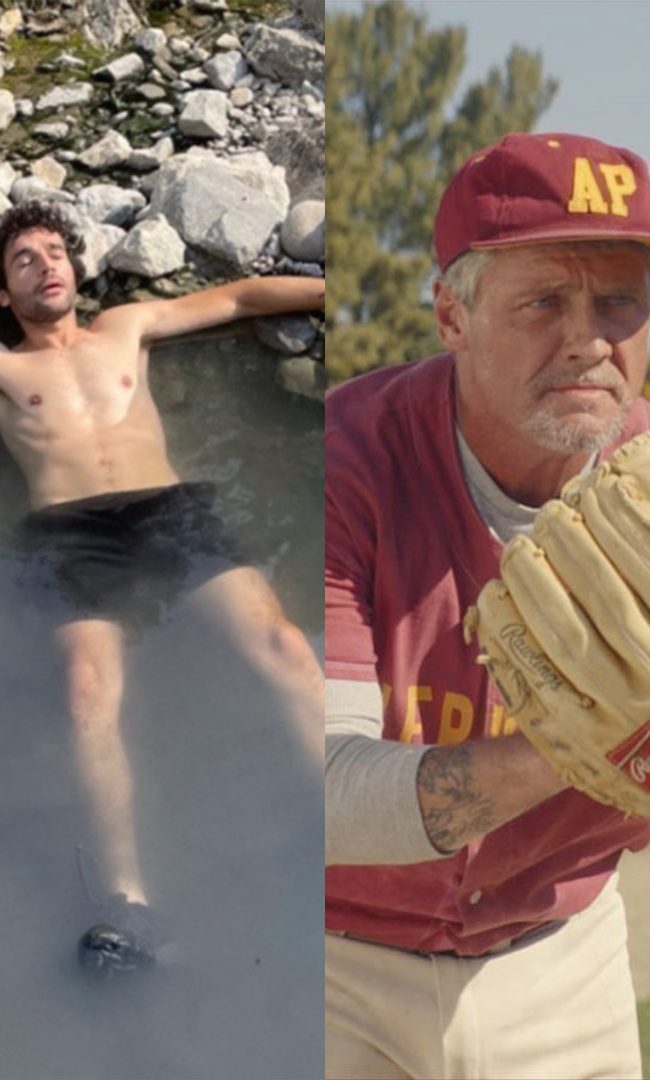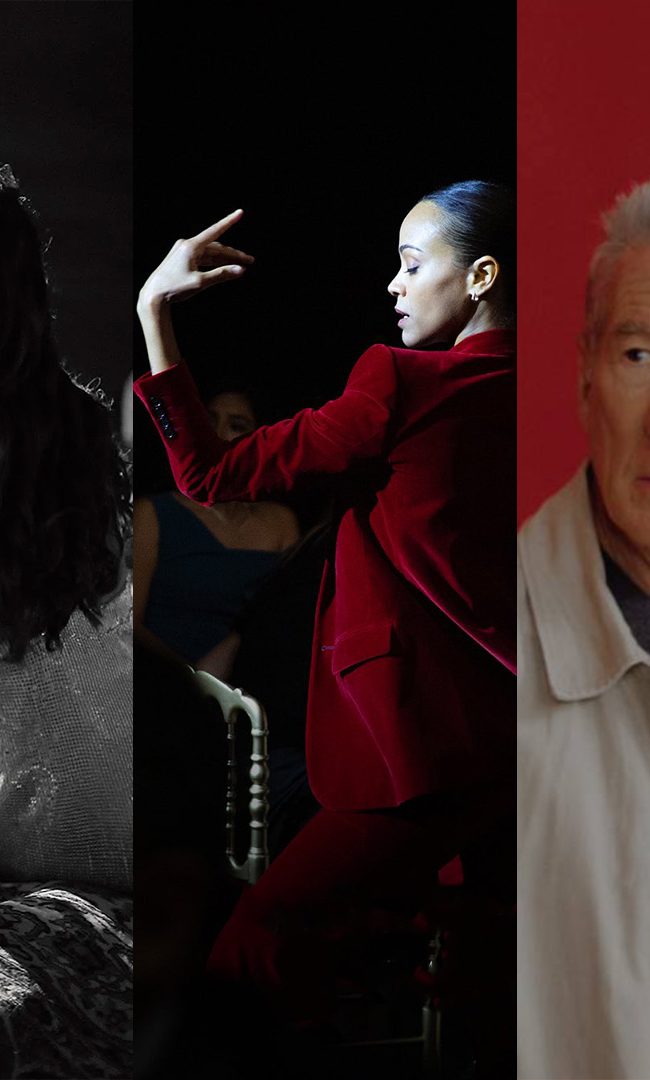OVER YOUR CITIES GRASS WILL GROW
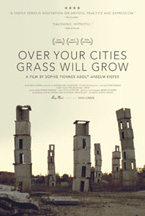
(Over Your Cities Grass Will Grow is now available on DVD through Alive Mind/Kino Lorber. It world premiered out of competition at the 2010 Cannes Film Festival and was picked up for distribution by Alive Mind Cinema. It opened theatrically at the Film Forum on August 10, 2011. Visit the film’s official website to learn more.)
Anselm Kiefer’s art overwhelms. Twenty feet high canvases thickly covered in layers upon layers of paint. Metal, stone and wood sculptures weigh many tons, filling galleries and museums. The quality of massiveness overpowers but in a way that empowers; the questions Kiefer raises in his work are absolute but purposefully left unanswered, allowing the audience a space to interpret, to take part. Similarly, Sophie Fiennes’ film Over Your Cities Grass Will Grow, which specifically explores Kiefer’s work in the south of France from 2000 to 2010, can at times challenge with its uncompromising vision, but ultimately it invites the viewer in to wander and wonder together with the filmmaker about the artist’s craft.
We start underground, in the caves. The camera is not a tour guide leading us through a museum but rather assumes control of our consciousness, deciding not only what we see, but how long we see it and from what perspective. We slink through golden caves, lit only by the occasional skylight, at a rate half a second slower than a normal walking pace. This encourages us not to gloss over something that we ordinarily take for granted—in this case, light and the absence thereof. As we get closer and further away from each skylight, what we can see and thus know changes with every step.
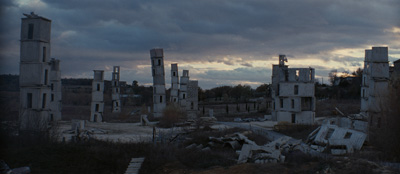 The feeling is unsettling at first; there is no way to know if this is a 10-minute lyrical introduction to more accessible content or if we are going to be led by the hand for the next two hours. The music haunts, almost anticipates the images, but certainly offers no indication as to a narrative progression or change of direction. So, any change, however infinitesimal, is held onto, studied, infused with meaning. At around the 15-minute mark, the camera tracks over the text ‘DAAD’ on a painting. Just seeing text reaffirms the sign of human intervention (though of course everything seen before was as well) and implies a narrative progression.
The feeling is unsettling at first; there is no way to know if this is a 10-minute lyrical introduction to more accessible content or if we are going to be led by the hand for the next two hours. The music haunts, almost anticipates the images, but certainly offers no indication as to a narrative progression or change of direction. So, any change, however infinitesimal, is held onto, studied, infused with meaning. At around the 15-minute mark, the camera tracks over the text ‘DAAD’ on a painting. Just seeing text reaffirms the sign of human intervention (though of course everything seen before was as well) and implies a narrative progression.
Then, a little later, the first sign of human life. A man is seen amidst this awesome landscape. It is a sigh of relief seeing the person responsible for this world, someone with whom to converse, to serve as intermediary between you and what you see. But, then, another man. Likely, many people who see this film are only somewhat familiar with Kiefer and his work and might not know what he looks like. The emergence of the second man draws into question the identity of the first. Though, soon enough, the appearance of a third man, undoubtedly (and actually) Kiefer, lays to rest the questions brought about by the first two. Kiefer is slightly taller and a few years older than the workers in his studio, his hands are dirty and work-worn though not as much as his assistants. His gait is dominant, though subtle. Kiefer’s emergence at about the 20-minute mark shows Fiennes’ bias with the work over its creator; a shot with Kiefer seen from behind out of focus in front of one of his massive paintings further cements this. At his request, the painting is brought closer to him and stays in focus, while he remains obscured.
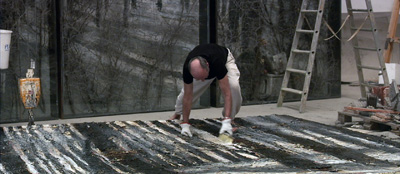 Once finally introduced, Kiefer is open, generous, arresting in his calmness. He plods through his studio in flip flops, throwing glass in the air until it falls just right, tossing cement blocks at paintings until completely satisfied. His relationship with his assistants Alain, Boualem and Lior is endearing, oddly convivial. Kiefer kindly asks them to do things, and if the task is not completed to his satisfaction, he never scolds or raises his voice but instead instructs with care and attention. The relationship feels more paternal than professional. These interactions provide a much needed human touch that grounds him and his work; they give what is largely opaque and cerebral a human dimension.
Once finally introduced, Kiefer is open, generous, arresting in his calmness. He plods through his studio in flip flops, throwing glass in the air until it falls just right, tossing cement blocks at paintings until completely satisfied. His relationship with his assistants Alain, Boualem and Lior is endearing, oddly convivial. Kiefer kindly asks them to do things, and if the task is not completed to his satisfaction, he never scolds or raises his voice but instead instructs with care and attention. The relationship feels more paternal than professional. These interactions provide a much needed human touch that grounds him and his work; they give what is largely opaque and cerebral a human dimension.
When Kiefer is seen working, Fiennes omits the music and lets the rhythm of the movement carry the flow. With works this big, a dance-like quality emerges as he and his workers move around the studio. When Kiefer throws white paint over a work, or when Alain throws a powder onto a painting to preserve it, their movements are mesmerizing, almost mystical. It is counter-intuitive how unpretentious this all is; one man, with some help, casually walking about a room filled with shards of glass and slabs of stone, making art that sells for millions of dollars. Though it is this effortlessness—the grace—that affirms Kiefer’s mastery.
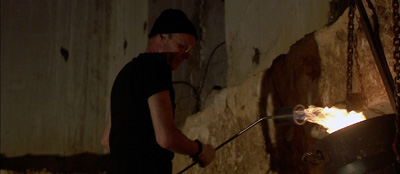 After this hour-long stretch of verité, Kiefer is seen sitting in a small library in an interview setting. It’s a break in the narrative, an interlude that offers the interviewer and the audience insight into his process and what we’ve seen so far. Here, Kiefer is different, slightly ornery; it seems he accepts this part of the job though yearns to be back in his studio making things, not talking about them. Much of the conversation is abstract, with Kiefer delving into the philosophical and ontological origins of his work. He explains how inhuman humans are, how unaware we are of ourselves. The comment is not so much arrogant as sad. He explains that boredom, a source of inspiration for him, is the base of existence, that that is when you are truly aware of yourself. Fiennes pantomimes this comment beautifully; the meandering through the caves, the distance from our protagonist tests us, demands our patience and gives us the reward in the process itself.
After this hour-long stretch of verité, Kiefer is seen sitting in a small library in an interview setting. It’s a break in the narrative, an interlude that offers the interviewer and the audience insight into his process and what we’ve seen so far. Here, Kiefer is different, slightly ornery; it seems he accepts this part of the job though yearns to be back in his studio making things, not talking about them. Much of the conversation is abstract, with Kiefer delving into the philosophical and ontological origins of his work. He explains how inhuman humans are, how unaware we are of ourselves. The comment is not so much arrogant as sad. He explains that boredom, a source of inspiration for him, is the base of existence, that that is when you are truly aware of yourself. Fiennes pantomimes this comment beautifully; the meandering through the caves, the distance from our protagonist tests us, demands our patience and gives us the reward in the process itself.
At the end of the interview, a young boy stumbles into frame and hangs there for a moment. It’s awkward, clearly unstaged. Fiennes decision to include it shows a deep humanness in Kiefer’s work (and hers)—amidst this conversation of absolutes there are people, children. Though Kiefer’s art has come to mean a great deal and to question even more, it is made of natural things, of wood, of paint, of stone. Beneath the chaos is simplicity.
Back in Barjac, Kiefer packs up his estate, moving it to outside Paris. He stands in the ruins he’s built, what looks like Stonehenge piled on top of itself several times. He recounts how much he loves the story of Lilith from the Bible, how the notion of everything becoming decayed and grass growing over it ‘fascinates’ him. As Fiennes weaves in and out of his work and into nature, up staircases that just end and tunnels that eventually stop and out into the sunbathed forest, you can understand his point.
– Jesse Klein








